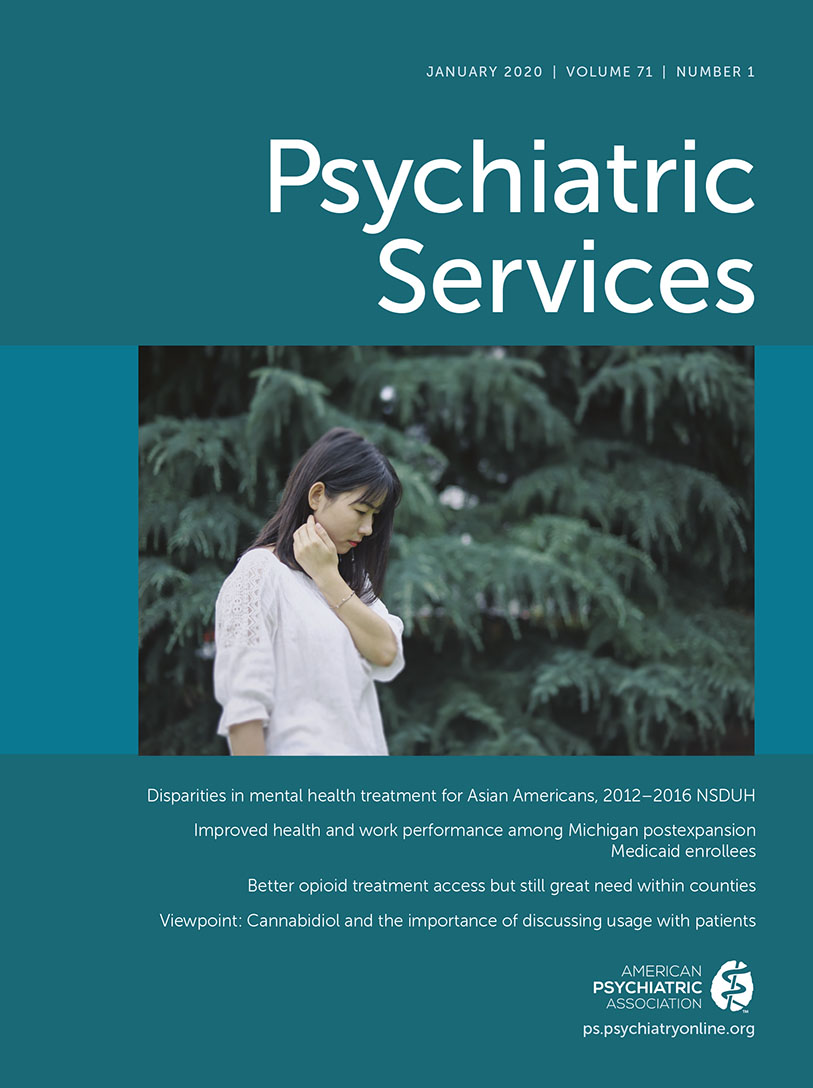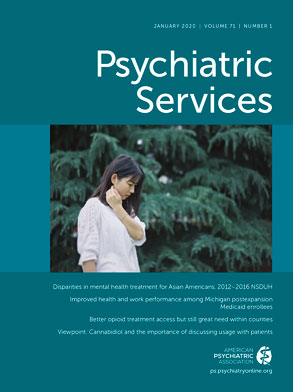In clinical practice, involuntary psychiatric admission is used for patients with severe mental illness who do not have the capacity to make rational decisions about treatment. The prevalence of involuntary psychiatric admission varies greatly within and across countries. Voluntary psychiatric admission indicates that patients consent to receive psychiatric inpatient treatment. After the introduction of mental health regulations and the growing awareness of the human rights of mentally ill people, the rate of voluntary admissions has increased (
1). Nevertheless, the provision of psychiatric care without the patients’ consent remains a contentious matter because of the sensitive balance between the benefits of treatment and the patients’ autonomy. There is compelling evidence that involuntary and voluntary admissions have different outcomes. Involuntary psychiatric admissions are linked with poor treatment satisfaction and treatment adherence, whereas voluntary admissions are more likely to lead to better therapeutic relationships and treatment adherence (
2).
In China, approximately 173 million people suffer from a psychiatric disorder (
3). The topic of involuntary psychiatric admissions often stimulates vigorous debates about human rights in China. Some studies have examined the prevalence of voluntary or involuntary psychiatric admissions in China, but findings are mixed. This systematic review and meta-analysis was conducted to examine the prevalence of involuntary and voluntary admissions for severe mental illness that included schizophrenia, bipolar disorder, and major depressive disorder in China.
Methods
The PubMed, Cochrane Library, PsycINFO, EMBASE, CNKI, CQVIP, and WanFang databases were independently and systematically searched from their inception date until October 3, 2018. Search terms are listed in the online supplement to this report.
The inclusion criteria were that the articles were peer reviewed and published in Chinese or English. In addition, the studies involved people with a diagnosis of schizophrenia, bipolar disorder, or major depressive disorder; reported the prevalence of voluntary or involuntary admission; and were conducted in China. Case studies, commentaries, and systematic reviews were excluded.
After exclusion of duplicate publications, the titles and abstracts of relevant publications were screened, and two authors (W.L. and Y.Y.) independently reviewed the full texts for eligibility. The same authors also independently extracted the following data: first author, publication year, study design and site, sample size, mean age of the sample, and rate of voluntary and involuntary admissions.
Study quality was assessed according to the modified version of the Agency for Healthcare Research and Quality criteria for observational studies (
4). Weighted scoring criteria were used, and a summary score was calculated for each study: a total score of ≥67 was considered high quality, 50–66 was considered moderate quality, and <50 was indicative of poor quality (
4).
The statistical analysis was performed with Comprehensive Meta-Analysis Version 2.0. The random-effects model was used to take into account differences in demographic characteristics and sampling methods across studies. Heterogeneity between studies was assessed with the Q and I2 statistics; an I2 value >50% or a p value <0.10 was considered evidence for significant heterogeneity. If significant heterogeneity was observed, a sensitivity analysis was performed.
Subgroup analyses were conducted to determine the moderating effects of categorical variables on the voluntary and involuntary admission rates. Metaregression analyses were conducted to examine the moderating effects of continuous variables on the results when the number of included studies was at least 10. Funnel plots and Egger’s test were used to evaluate publication bias. All meta-analytic outcomes were analyzed at a two-tailed significance level of 0.05.
Results
Of the 470 potentially relevant studies, 14 studies covering 94,305 patients (52,971 males) satisfied the study eligibility criteria (see online supplement). The rates of all psychiatric admissions for severe mental illness ranged from 8.5% to 75.4% for voluntary admissions and 3.6% to 74.7% for involuntary admissions (see online supplement).
The quality assessment scores ranged from 57 to 75. Only one study was rated as high quality (
1), whereas the rest were of moderate quality (see
online supplement). The funnel plot and Egger’s test did not show evidence of significant publication bias for the pooled voluntary admission rate of severe mental illness (t=0.03, df=9, 95% CI=–26.59 to 25.84; p=0.97).
The overall voluntary admission rate of all psychiatric admissions for severe mental illness was 30.3% (95% CI=18.06% to 46.23%, I2=99.89%), whereas the overall involuntary admission rate was 32.3% (95% CI=10.39% to 66.21%, I2=99.96%; see online supplement). For patients with schizophrenia, the pooled voluntary and involuntary admission rates were 19.6% (95% CI=14.09% to 26.54%, I2=95.81%) and 44.3% (95% CI=5.98% to 90.88%, I2=99.92%), respectively. The voluntary rates for depression and mania were 32.1% and 10.9%, respectively.
Of subgroup analyses are presented in the online supplement. The western regions of China were significantly more likely to have a higher prevalence of voluntary admissions for severe mental illness. Studies involving multiple sites reported lower rates of involuntary admissions. Sensitivity analyses were performed by removing one study sequentially, without change in the primary results. Metaregression analyses revealed an increasing voluntary admission rate over time (slope=0.15, p<0.001); higher study quality was associated with lower voluntary admission rates (slope=–0.16, p<0.001; see online supplement).
Discussion
The pooled involuntary admissions rate (32.3%) was higher than the voluntary admissions rate (30.3%), and this difference was more pronounced for schizophrenia (44.3% versus 19.6%). The frequency of involuntary admissions varies greatly across the world, even in the same area. In Europe, for example, the frequency ranges from six to 218 per 100,000 in Portugal and Finland, respectively (
5), with an increase of involuntary admissions in Germany, France, and the United Kingdom (
6). The wide range of involuntary admission rates is probably due to differences in sociocultural background, civil liberties, mental health regulations and law, psychiatric treatment traditions, psychiatrists’ education and training, psychiatrists’ assessment of the severity of psychopathology and risk of aggression and suicidality. Due to the complexity of issues determining the selection of the local legal framework for psychiatric admissions, country-by-country direct comparisons should be conducted with caution.
Consistent with previous findings (
1), the diagnosis of schizophrenia was significantly associated with an increased risk of involuntary admissions. In Ireland, patients with schizophrenia and related disorders had the highest prevalence of involuntary admissions, followed by affective disorders (
7). Schizophrenia accounts for 42.1%−60.9% of all involuntary admissions (
7,
8). Reasons for the higher involuntary admissions rate in schizophrenia compared with other diagnoses include poor insight and severe and frequent aggressive behavior (
9).
The increase of voluntary admission rate over time could be partly explained by the growing mental health awareness in Chinese society and the subsequent reduction of stigma. In the past two decades both the Chinese government and health authorities have made great efforts to alleviate stigma related to severe mental illness through public education and the release of new national and local mental health laws. The changing legal framework and social atmosphere surrounding severe mental illness encourage patients and their families to seek help from mental health services.
Another possible reason for the increased rate of voluntary admissions in China is the easier access to the rapidly expanding mental health services and wider coverage of the health insurance system (
10). In the past two decades, more psychiatric hospitals and clinics have opened, and more mental health professionals have been trained. Whereas there were only 16,103 licensed psychiatrists, 24,793 psychiatric nurses, and 129,314 psychiatric beds in China in 2004, these figures increased to 27,733 licensed psychiatrists, 57,591 psychiatric nurses, and about 433,000 psychiatric beds by 2015 (
10). Further, novel psychotropic drugs are now covered by health insurance in China: only fluoxetine, paroxetine, risperidone, and clozapine were covered in 2004, but since 2017, health insurance has paid for most psychotropic drugs. Most patients now have access to affordable mental health services (
11). In addition, involuntary admissions are an important policy issue in China. The implementation of China’s new National Mental Health Law in 2013 could also contribute to the growing rate of voluntary admissions. The law emphasizes respect for psychiatric patients’ human rights and their protection in relation to hospital admission, treatment, and discharge. In particular, the law mandates that admissions to a psychiatric hospital should be determined by the patients themselves, except when the illness results in lack of insight or in aggressive or destructive behavior (
12). By recognizing self-determination as a patient’s right, the law acknowledges the greater efficacy of treatment when consent is obtained. This recognition, in turn, may encourage patients and their families to seek voluntary admission in the future.
Subgroup analyses showed that studies in the western regions of China had higher voluntary admission rates and studies with multiple sites reported lower involuntary admission rates. Although there were no high-quality studies to test the direct impact of China’s new National Mental Health Law on voluntary and involuntary admission rates, observational studies suggest a trend that may enable eventual comparison. A positive trend toward voluntary admissions over time was found, indicating that the implementation of China’s National Mental Health Law in 2013 might have helped to boost voluntary psychiatric admissions, although the difference between pre- and postimplementation of the law did not reach statistical significance. These results could be explained by the uneven geographic distribution of articles in each subgroup: two studies were conducted in western China after implementation of the law, and only one study had a single-site design. With more time for evidence to accumulate, future research should reexamine the impact of the 2013 Mental Health Law.
This study had several limitations that need to be acknowledged. First, the findings cannot be generalized to all areas of China, because most studies originated from eastern China. Second, this work was limited in its heterogeneity across studies, as is typical of meta-analytic studies (
13). We performed subgroup and sensitivity analysis to mitigate this limitation. Third, there were insufficient data to analyze certain variables related to voluntary and involuntary admission, such as education level, improvement of treatment, and recovery of severe mental illness. Fourth, very few studies examined voluntary and involuntary admission in bipolar disorder and major depressive disorder; therefore, meta-analysis could not be performed concerning those disorders. Finally, the impact of the National Mental Health Law on involuntary admission rates could not be rigorously examined due to lack of data.

